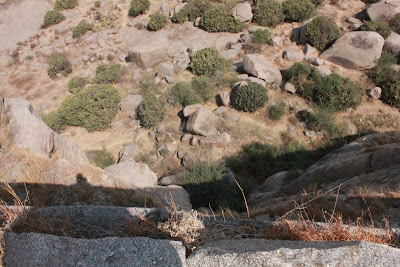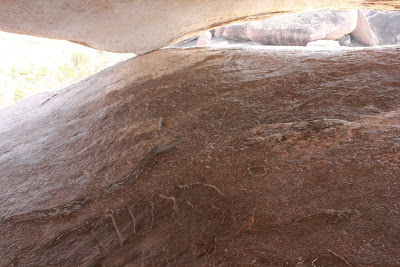First week May 2012
My Dodappa's invitation to join him and cousin Naveen at Mudhol was unexpected. It would be an opportunity to meet my Dodappa's brother-in-law Ramesh. Uncle asked me to confirm right away. My mind in a turmoil because of work related issues. I accepted Dodappa's invite, it would do me good to spend time with family. I confirmed. The plan was to reach Mudhol May 6th morning.
May 6, 2012
I left Dharwad by 6-15. Dharwad-Saundatti was like a cross country drive ...road construction work had commenced few weeks ago. Saundatti-Munvalli-Lokapur-Mudhol was a breeze. It was 8-20 when I drove into Ramesh uncle's farm. I was seeing Ramesh uncle after many years. Uncle had not changed much in those years, slim and fit like before. I was glad to see Ramesh uncle's mother too.
At 10-30 Kanbur lawyer joined us and we all went to Jamkhandi to see a cousin. We left Jamkhandi after lunch and headed towards Halgali, our destination was Kanbur's dairy farm. On the way Kanbur lawyer told us about an anti-British uprising in Halgali by Valmiki people (hunter tribesmen). The uprising was instigated by two brave warriors Jada and Bala. The uprising which started with slaying of 3 British officer ended with the execution of 16 Valmiki tribesmen including Jada and Bala. On the way back we stopped to see relatives at at Halgali. I was introduced to a school headmaster who narrated the Halgali incident. A relative even presented a book about history of Halgali.The headmaster told us about a lake in the jungle and other spots. He also mentioned a elephant tomb at Galgali. Later Kanbur lawyer took us to an ancient temple, Veerabhadresvaragudi. We left Halgali back to Mudhol, visited Kanbur lawyer's home and later he dropped us back to the farm. We planned to visit Galgali next morning.
May 7, 2012
Kanbur lawyer had called his acquaintance at Galgali- Mr.Nyamgoudar. We went straight to Nyamgoudar's home, got introduced, had a cup of tea and we were set to go to the elephant tomb. Nyamgoudar's nephew Anand was appointed our guide. Two minute walk through the main street of Galgali we reached the monument. I was expecting to see a four-pillared structure... nothing of that sort. It was simple raised platform but large enough to match an elephant's size. The monument is within the Gram Panchayat office compound. If not for this location, probably this monument would be unknown or worst it would have been vandalized and lost forever.
Anand volunteers to climb up. Then I too clamber up. The circular sculpture would be a lotus, I guess.
A pair of lions and a pair of elephant sculptures decorate the front part of the grave.
Not much information about this monument is available but people did mention that the elephant served in the tyrant Aurangzeb's army during his Deccan campaign. According to an online document from The Gazetteers Department - Bhir; Aurangzeb moved out of Maharatsra and established a camp at Galgali in 1690. In 1695 Aurangzeb had his camp moved to Brahmapuri (Solapur district, Maharastra). The document does mention use of elephants while camping at Galgali. Going by the these facts, this grave must have been built some time between 1690 and 1700.
I do not remember anyone saying that tyrant Aurangzeb himself rode this elephant. I wonder what the elephant was called as ...surely it would have had a name.
Floral art on two other sides. The fourth side was too close to a wall and plants had filled the gap.
That's Naveen, Vijay uncle and Nyamgoudar. A badami tree is the only shelter the elephant grave has.
Muslim rulers- Adil Shahis, Bahamanis, Mughals and many more -are known for their massive and expensive tombs. The kings would have their tombs built while they lived. But having a tomb built for an elephant is something different.
A short video-
On the way back home the elders went ahead. I stopped to buy a chilum from this cart shop selling tobacco, betelnuts and paan leaves. The Rs.10 chilum is made of clay.
That's Nyamgoudar's house. We exchange phone numbers, thank them and leave.
Galgali is a village on river Krishna's west bank. We went for a drive on the bridge across the mighty Krishna. The river was almost dry except for large ponds in the rocky bed. On the left was a barrage running the entire span of the riverbed. On the right I could see few boys diving into the ponds and swimming. Uncle would have loved to go for a swim ...bad luck- he was not carrying his swimming trunks.
Like any other village Galgali has two ancient temples; one of the temples is built on the rocky river bed, close to where boys were swimming. I wish I had checked out the temples but we were expected at Yedahalli Desai's vaade.
Elephant grave's approximate coordinates: 16°25'6"N 75°26'17"E.........








































































